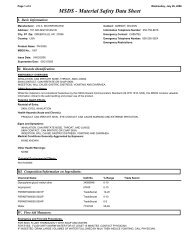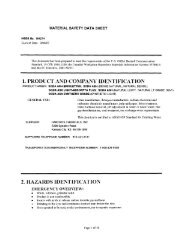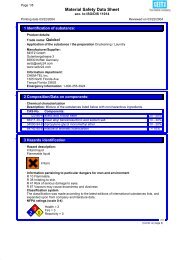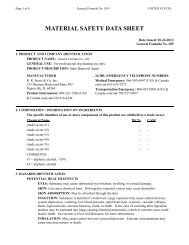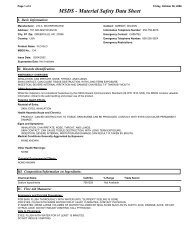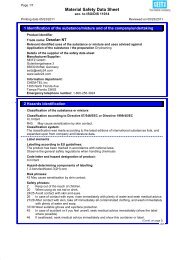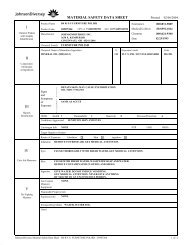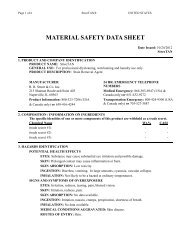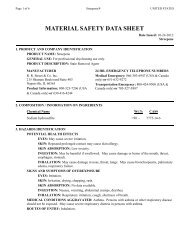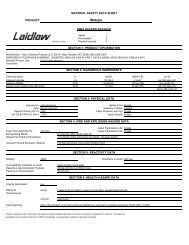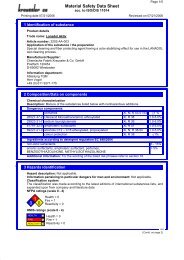MSDS Calcium Hypochlorite - FabriClean Supply
MSDS Calcium Hypochlorite - FabriClean Supply
MSDS Calcium Hypochlorite - FabriClean Supply
You also want an ePaper? Increase the reach of your titles
YUMPU automatically turns print PDFs into web optimized ePapers that Google loves.
Harcros Chemicals Inc<br />
MATERIAL SAFETY DATA SHEET Page 4<br />
--------------------------------------------------------------------------------------------------<br />
CHEMICAL NAME : CALCIUM HYPOCHLORITE<br />
DATE: 29-Mar-2006<br />
--------------------------------------------------------------------------------------------------<br />
SECTION IV FIRE & EXPLOSION HAZARD DATA<br />
(CONTINUED)<br />
_<br />
UNUSUAL FIRE & EXPLOSION HAZARDS<br />
Product does not burn, but can provide oxygen which can intensify a fire. Intense heat may<br />
cause pressure buildup and rupture container. Product is an oxidizer. It may react vigorously<br />
with organics or other materials resulting in an explosion and fire.<br />
------------------------------<br />
SECTION V PHYSICAL DATA<br />
------------------------------<br />
Boiling Point: N/D<br />
Freezing Point: N/D<br />
Specific Gravity (H(2)O=1):0.800 to 2.350 @ 68 Deg. F<br />
Vapor Pressure (MM HG.): N/D<br />
Vapor Density (AIR=1) : N/D<br />
Evaporation Rate ( NA=1): N/D<br />
Solubility in Water: 17%<br />
Percent Volatile by Volume: N/D<br />
pH: aqueous approx. 8.00 to 11.000<br />
Appearance:<br />
SOLID - POWDER, CRYSTAL, FLAKE, GRANULE<br />
TABLET, PRILL, BRIQUETTE, ETC.<br />
Odor :<br />
SHARP<br />
------------------------------<br />
SECTION VI REACTIVITY DATA<br />
------------------------------<br />
STABILITY<br />
Unstable.<br />
INCOMPATABILITY<br />
inorganic acids organic mixtures Avoid contact with strong reducing agents which include<br />
hydrogen, hydrazine, sulfides, sulfites, and nitrites. Product is an oxidizer. It may react<br />
vigorously with organics or other materials resulting in an explosion and fire.<br />
CONDITIONS TO AVOID<br />
Heat, heated surfaces, static electricity, electric arcs, sparks and flames.<br />
HAZARDOUS DECOMPOSITION PRODUCTS<br />
Acid or Ammonia combination will release toxic gases. Excessive heat results in release of<br />
Oxygen and Chlorine gas.<br />
HAZARDOUS POLYMERIZATION<br />
_<br />
Continued On Page 5



